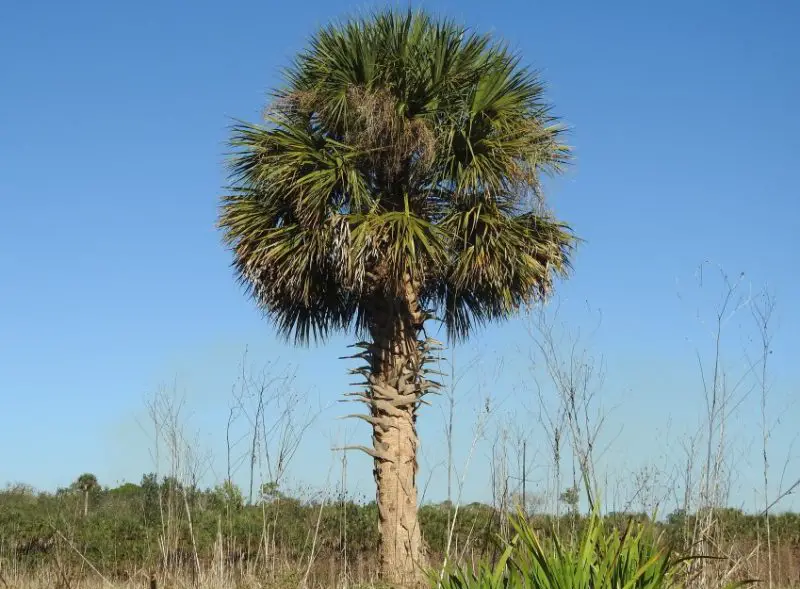Sabal palmetto, also known as the cabbage palm, is a hardy and iconic palm tree native to the southeastern United States. This majestic tree is widely appreciated for its resilience, aesthetic appeal, and ecological benefits.
If you’re considering growing Sabal palmetto, this comprehensive guide will provide you with everything you need to know about its care, growth requirements, and maintenance.
Understanding Sabal Palmetto

What is Sabal Palmetto?
Sabal palmetto is a species of palm that belongs to the Arecaceae family. It is characterized by its fan-shaped leaves, robust trunk, and ability to thrive in various environments. It is commonly found in coastal regions, wetlands, and even urban landscapes.
Benefits of Growing Sabal Palmetto
Drought Tolerance
Sabal Palmetto is well-adapted to dry conditions and requires minimal watering once it is fully established. This makes it an excellent choice for landscapes in regions with limited rainfall or areas prone to drought. Once the tree develops a deep root system, it can efficiently access underground moisture, reducing the need for frequent irrigation. This characteristic not only conserves water but also lowers maintenance costs for homeowners and landscapers.
Salt Resistance
One of the standout features of Sabal Palmetto is its high salt tolerance, making it a perfect choice for coastal environments. It thrives in sandy soils and can withstand salt spray from the ocean, which would be harmful to many other tree species. This resilience allows it to grow in seaside landscapes, barrier islands, and beachfront properties without suffering damage from salty winds or soil salinity.
Wind Resistance
Sabal Palmetto is known for its exceptional ability to withstand hurricanes, tropical storms, and strong winds. Its flexible trunk and sturdy fronds allow it to bend rather than break under extreme weather conditions. This durability makes it a popular choice for hurricane-prone regions, where homeowners and city planners seek trees that can endure harsh storms while minimizing damage to surrounding structures.
Wildlife Support
Beyond its resilience, Sabal Palmetto plays a vital role in supporting local wildlife. The tree produces small, black berries that provide a nutritious food source for birds, squirrels, and other animals. Additionally, its dense fronds offer shelter and nesting sites for various bird species and insects. Bees and butterflies are also attracted to its flowers, contributing to local pollination and biodiversity.
Aesthetic Appeal
With its tall, slender trunk and gracefully arching fronds, Sabal Palmetto adds a striking visual element to any landscape. Its tropical appearance enhances gardens, parks, and urban spaces, creating a lush, exotic ambiance. Whether used as a standalone specimen or planted in rows along streets and pathways, this palm tree brings both beauty and functionality to outdoor spaces.
How to Grow Sabal Palmetto
Choosing the Right Location
Sabal Palmetto thrives in full sun and well-draining soil, making it ideal for a wide range of landscapes, including coastal areas, urban spaces, and large yards. Since these palm trees can grow up to 80 feet in height and have a canopy spread of 12 to 18 feet, it’s crucial to select a planting site with ample vertical and horizontal space. Avoid planting them too close to buildings, power lines, or other structures to allow for unrestricted growth.
Additionally, Sabal Palmetto is highly adaptable to different environmental conditions, but for optimal growth, it should be placed in an area with good air circulation and minimal competition from larger trees or shrubs.
Soil Requirements
Sabal Palmetto is naturally found in sandy coastal regions, making it well-suited to various soil types. However, for healthy growth, consider the following soil conditions:
- Prefers sandy, loamy, or well-drained soils, which allow water to flow freely and prevent root rot.
- Tolerates a range of pH levels, from slightly acidic to slightly alkaline, making it adaptable to different soil compositions.
- Avoid planting in overly compacted or poorly drained soils, as these can lead to root suffocation and slow growth. If dealing with clay-heavy soil, consider amending it with sand or organic matter to improve drainage.
Planting Sabal Palmetto
Step 1: Dig a Proper Planting Hole
- Dig a hole twice as wide as the root ball to allow ample room for root expansion.
- Ensure the hole is deep enough so that the root ball sits level with or slightly above the ground surface to prevent settling.
Step 2: Position the Tree
- Carefully place the palm in the hole, ensuring that the root ball is stable and level with the ground.
- If transplanting from a container, gently loosen the roots before planting to encourage outward growth.
Step 3: Backfill with Soil
- Gradually fill the hole with soil while pressing gently to eliminate air pockets.
- Avoid burying the trunk too deeply, as this can lead to rot or pest issues.
Step 4: Water Thoroughly
- After planting, provide deep watering to help the roots establish.
- Continue watering once or twice a week for the first few months, depending on rainfall and soil moisture levels.
Step 5: Mulch Around the Base
- Apply a 2-3 inch layer of organic mulch, such as pine bark or wood chips, around the base of the tree.
- Keep the mulch a few inches away from the trunk to prevent rot and fungal issues while helping retain moisture and suppress weeds.
Sabal Palmetto Care Guide
Watering Needs
Proper watering is essential for Sabal Palmetto, especially during its early growth stages. While mature trees are highly drought-tolerant, young palms need consistent moisture to develop a strong root system.
- Young palms: Water deeply once or twice a week to encourage deep root growth. Newly planted Sabal Palmettos require consistent moisture, but the soil should not remain soggy. Deep watering helps roots establish and improves long-term drought resistance.
- Established palms: Once the tree matures, it requires little irrigation. However, during prolonged dry spells, occasional deep watering will keep it healthy, especially in sandy or fast-draining soils.
- Avoid overwatering: Excess moisture can lead to root rot, a common issue in palms planted in poorly drained soil. To prevent this, allow the soil to dry slightly between waterings and ensure proper drainage.
Sunlight and Temperature Requirements
Sabal Palmetto thrives in warm, sunny environments and is well-adapted to tropical and subtropical climates.
- Sunlight: It grows best in full sun, receiving at least 6-8 hours of direct sunlight daily. While it can tolerate partial shade, full sun exposure promotes healthier growth and a more robust trunk.
- Temperature: This palm prefers warm, humid climates and is hardy in USDA zones 7-11. It is commonly found in coastal regions, where temperatures remain mild year-round.
- Cold Tolerance: Sabal Palmetto can endure short periods of frost, but prolonged exposure to freezing temperatures can cause damage to the fronds and slow growth. In colder regions, protection measures such as mulching around the base or wrapping the trunk may help reduce frost damage.
Growth Rate
Sabal palmetto has a slow to moderate growth rate. It can take several years for the palm to develop a noticeable trunk, with an average growth of 6 inches to 1 foot per year under optimal conditions. The growth rate can be influenced by soil quality, water availability, and climate factors. While slow-growing initially, once established, it can reach heights of 40 to 80 feet over several decades.
Fertilizing Sabal Palmetto
Fertilization plays a crucial role in promoting healthy growth and preventing nutrient deficiencies in Sabal Palmetto. A slow-release, balanced palm fertilizer containing essential micronutrients like magnesium, potassium, and manganese is ideal for maintaining its vibrant green foliage and strong root system.
During the growing season in spring and summer, applying fertilizer every three to four months ensures steady nutrient absorption. This helps the palm develop a robust trunk and lush canopy. However, it is important to avoid over-fertilization, as excessive nutrients can lead to leaf burn and weak growth.
In some cases, Sabal Palmetto may show signs of magnesium or potassium deficiency, particularly in sandy soils where nutrients leach quickly. If yellowing leaves or frond discoloration appear, supplementing with magnesium sulfate (Epsom salt) or potassium-rich fertilizer can help restore its health. Always follow manufacturer guidelines to prevent overuse.
Pruning and Maintenance
Routine pruning is essential for keeping Sabal Palmetto healthy and visually appealing. Removing dead or damaged fronds prevents pest infestations and reduces the risk of disease. However, it is crucial to avoid over-pruning, as the tree relies on its fronds for photosynthesis and overall strength. Cutting too many green fronds can weaken the palm, slowing growth and increasing vulnerability to environmental stress.
One of the most important rules in Sabal Palmetto maintenance is never cutting the spear leaf, the central, newly emerging frond. This leaf is the tree’s growing point, and removing it can lead to irreversible damage or even the palm’s death.
With proper fertilization and careful pruning, Sabal Palmetto will remain a hardy, low-maintenance addition to any landscape, thriving for decades with minimal intervention.
Common Pests and Diseases
Sabal Palmetto is a hardy and resilient palm, but like any tree, it can be affected by certain pests and diseases. Proper care, including maintaining soil health, proper watering, and routine inspections, can help prevent most problems.
Pests
One of the most damaging pests to Sabal Palmetto is the palm weevil. These large beetles bore into the trunk, where their larvae feed on the inner tissues, potentially leading to structural weakness and palm death. Early signs of infestation include wilting fronds and a foul odor from the trunk.
Scale insects are another common issue. These tiny, sap-sucking pests attach themselves to the leaves and stems, causing yellowing, stunted growth, and leaf drop. Heavy infestations weaken the palm, making it more susceptible to diseases.
Spider mites are microscopic pests that feed on the leaves, causing discoloration, speckling, and fine webbing on the fronds. They thrive in dry, hot conditions and can quickly spread if not controlled.
Diseases
One of the most serious diseases affecting Sabal Palmetto is Ganoderma butt rot, a fungal infection that causes the trunk to decay. This disease is fatal and has no cure, making prevention the best approach. Signs include a soft, rotting trunk and the presence of a conk (a shelf-like fungal growth) near the base.
Leaf spot is another common issue, caused by fungal or bacterial infections. It appears as brown or black spots on the fronds and can spread rapidly in humid conditions. While not usually fatal, it can weaken the tree if left untreated.
Lethal bronzing, a bacterial disease spread by insects, causes a slow decline in the palm. Early symptoms include premature fruit drop and leaf discoloration, progressing to total canopy collapse. Once infected, the tree cannot be saved, and removal is necessary to prevent the spread to other palms.
Prevention and Treatment
A strong, well-maintained Sabal Palmetto is more resistant to pests and diseases. Proper watering and fertilization ensure the palm stays healthy and less vulnerable to stress-related infections. Removing damaged or infected fronds promptly helps prevent disease spread and discourages pest infestations.
For pest control, using insecticidal soap or neem oil can effectively manage scale insects and spider mites. For fungal infections like leaf spot, applying a fungicide may help slow the disease’s progression. However, for severe issues such as Ganoderma butt rot or lethal bronzing, professional assessment and tree removal may be the only options.
Regular monitoring and proactive care can keep Sabal Palmetto thriving while minimizing the risks posed by pests and diseases.
Propagation of Sabal Palmetto
Growing from Seeds
Sabal Palmetto is primarily propagated through seeds, a natural but slow-growing process. To successfully grow a new palm from seed, start by collecting ripe seeds from mature trees. These seeds are typically found in late summer to fall, appearing as small, round, black fruits.
Before planting, soak the seeds in water for 24 to 48 hours to help soften the outer coating and improve germination rates. After soaking, plant the seeds in a well-draining soil mix, such as a combination of sand, peat, and perlite. Keep the soil consistently moist but not waterlogged, as excessive moisture can lead to fungal growth.
Germination can be a slow process, often taking several weeks to a few months, depending on environmental conditions such as temperature and humidity. Patience is key, as Sabal Palmetto grows slowly in its early stages. Once seedlings reach 6 to 8 inches in height, they can be carefully transplanted into larger containers or directly into the ground. When transplanting, choose a location with full sun and well-drained soil to ensure optimal growth.
Landscaping Ideas with Sabal Palmetto
Urban and Residential Landscapes
Sabal Palmetto is a striking addition to urban and residential landscapes, offering both aesthetic appeal and practical benefits. Its tall, stately trunk and elegant fronds make it an excellent choice for lining driveways and walkways, creating a grand entrance for homes, parks, or commercial properties.
For a more dramatic effect, it can serve as a focal point in tropical or coastal gardens, standing out among smaller plants. When paired with low-growing shrubs, colorful flowers, or ornamental grasses, Sabal Palmetto provides a beautiful contrast and adds vertical interest to the landscape.
Coastal and Naturalized Areas
Because of its exceptional salt tolerance, Sabal Palmetto thrives in beachfront properties and coastal landscapes where other trees might struggle. It is a preferred choice for areas exposed to salty air and sandy soils, making it a resilient option for oceanfront homes and resorts.
Beyond its beauty, Sabal Palmetto plays an essential role in erosion control. Its deep, fibrous root system helps stabilize sandy soils, reducing the impact of wind and water erosion in coastal environments. Additionally, it supports local wildlife by attracting birds, pollinators, and insects, contributing to a thriving ecosystem.
Whether used in residential gardens or naturalized coastal areas, Sabal Palmetto is a versatile and low-maintenance tree that enhances the landscape while providing long-term environmental benefits.
Conclusion
Sabal palmetto is a versatile and low-maintenance palm that adds beauty and resilience to any landscape. By following proper care practices, including appropriate watering, fertilization, and pest control, you can ensure a healthy and thriving tree for years to come. Whether you are planting it for aesthetic purposes, environmental benefits, or as a natural wind barrier, this palm is a fantastic choice for gardeners and landscapers alike.






